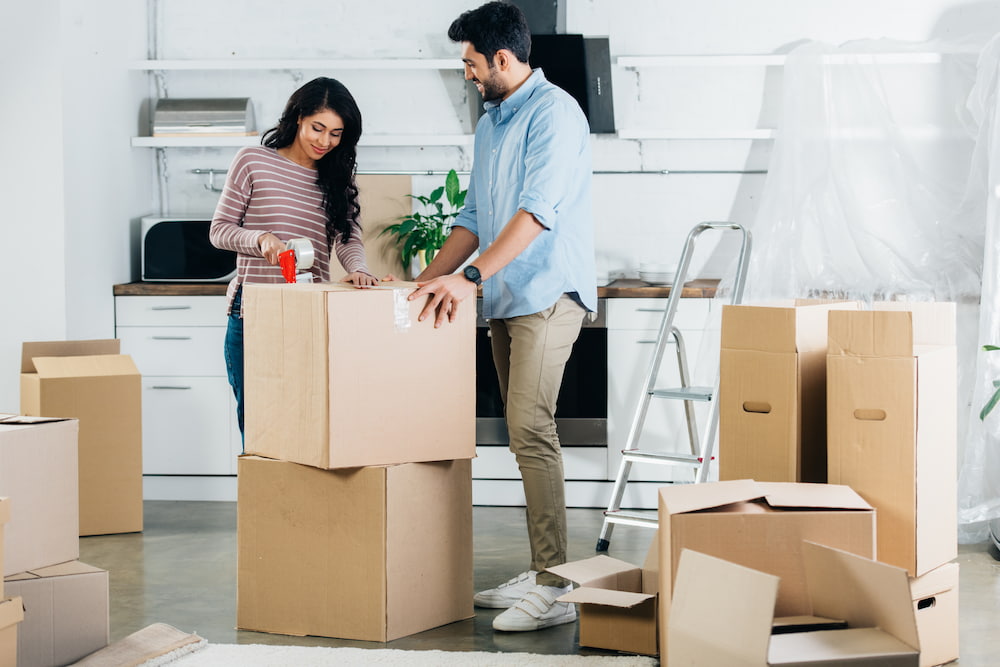22 Essential Moving Tips and Tricks for Packing Day

Searching high and low for the ultimate moving tips? We’ve got you covered with some awesome tricks for packing.
Packing is a major part of the moving process, but we know it can be overwhelming. Not everything in your home will fit perfectly into cardboard boxes, and some items will require more attention than others! That pink flamingo lamp will need some bubble wrap, but your socks can manage without. To help you find unique and effective ways to pack up your home, we’ve made a list of moving tips specifically for packing day. (You can thank us later.) If you haven't already read it, check out 11 hidden costs of moving to be prepared for your move.
If you’re ready to get packing, keep reading below!
1. Declutter First, Pack Second
Before you do anything else, decluttering should be your first step. Go through your home and decide what to toss, donate, or keep, because the more items you part with, the less you have to pack.
Pro tip: To avoid getting overwhelmed, declutter by room.
2. Get Supplies
After you declutter like crazy, you need to get all your packing supplies together. This includes moving boxes, plastic totes, box cutters, permanent markers, packing tape, trash bags and more. You can often find boxes for free from local businesses, but sometimes investing in durable supplies is beneficial.
Pro tip: If you’re unsure how many boxes to buy or rolls of tape to get, find a moving calculator online. This tool will help you determine what you need and how much to buy.
3. Make Your Own Box Handles
This hack is absolutely genius. Yes, it’s a great idea to buy boxes with handles—but old or free boxes may not have the luxury. So, make your own! Grab your box cutters and cut either a rectangle or upside-down triangle on each side. You can also use tape or rope to make DIY box handles.
Pro tip: Find more ideas to create handles on moving boxes in this blog.
4. Pack a Little Each Day
Make packing much more manageable by doing a little bit each day. Create a schedule and pack for a certain number of hours per day or per week, or make a goal to have a room packed within a designated time frame.
This will be extremely helpful in the long run, especially when compared to shoving everything into random boxes at the last minute. (Yeah, we went there.)
5. Create an Essentials Box
You’ll definitely appreciate this moving tip. Be sure to pack all your essentials separately. Items like toiletries, bedding, snacks, dinnerware and toilet paper should stay with you and not in the back of the moving truck. Avoid running to the store to buy a new toothbrush after a long day of moving.
Pro tip: Wondering what exactly to pack in your essentials box? Check out our moving essentials blog for 11 things you can’t forget!
6. Label Boxes
Label, label, label. When it comes to unpacking boxes in your new home, you’ll be so grateful that you took the extra time to thoroughly label your boxes.
Use different colored tape or markers for each room, and write the box number and general contents of the box on at least two sides.
Pro tip: You can even take a picture of the inside (with the label showing) so you have a general idea of what is in each box.
7. Pack Heavy Items in Small Boxes
This may go without saying, but be mindful when packing your boxes. Put heavy items in smaller boxes and lighter items in big boxes. This prevents any box from getting too heavy to carry or move safely.
Also, don’t over-pack your boxes. Putting too much in a box can sacrifice its structural integrity and make it too heavy. No one wants to watch their belongings crash to the floor after the bottom of the box broke.
8. Don’t Leave Empty Spaces
Even though you shouldn’t overpack boxes, you also need to ensure there isn’t any empty space. Do this by using extra packing material, not more items. Empty space in boxes can cause your items to shift around during the move. Avoid that by using extra paper, packing peanuts or foam.
9. Pack Breakables Carefully
Protect your breakable items by using lots of packing paper, foam and padding. Take the extra time now to ensure these fragile items are secure, so you can prevent damage later. This is an important long-distance moving tip—the farther your fragile belongings have further to travel, the more you want to ensure they’re extra protected!
10. Use Household Items as Packing Material
Speaking of breakable items, you can also use household goods to pad them. Grab your towels, sheets, socks and clothes to wrap these fragile items. You’ll conserve space and keep your belongings safe at the same time.
11. Use Large, Empty Items as ‘Boxes’
All those big, hollow items you’re getting ready to move can be used to pack! Instead of putting an empty suitcase in the moving truck, use it as a box. Fill items like suitcases, baskets and laundry hampers with belongings to make the most of your space.
12. Be Extra Careful with Knives
If you have a nice set of kitchen or chef’s knives, chances are you’ll want to take them with you on the move. But they’re sharp—so they require an extra level of caution. Either pack your knives in a block, or pack each separately. You’ll need tape, packing paper, a marker and bubble wrap.
Pro tip: Check out this guide for more detailed instructions on how to pack your knives.
13. Plates Should be Packed Vertically
Packing plates isn’t too difficult but remember to pack them vertically instead of flat. Add Styrofoam, padding or packing paper in-between the plates to help prevent breaking.
14. Plastic Wrap is Key
Cover all items that could spill during the move with a layer of plastic wrap between the bottle and the lid. You’ll be grateful later when your shampoo doesn’t leak all over the place!
15. Place Wet Items Separate from Dry Items
Even though you’ve taken the extra step to cover any items that could spill with plastic wrap, it’s still a good idea to pack them separately. You can also pack them in a plastic tote or bin to confine the mess just in case they spill.
16. Pack Clothes
There are a few different ways to pack your clothes. You can put them in vacuum seal bags to save space (this is a great idea for off-season clothing you may not need right away), use wardrobe boxes or keep them in drawers (only if the dresser isn’t too heavy). If you’d like to keep them on hangers, cut a hole in a trash bag and put the bag over the hangers to cinch several shirts or dresses together.
Pro tip: It may be tempting to leave clothing until the last minute, but avoid the stress of packing clothes in random boxes and plan ahead. Find more ideas for packing clothing in this blog.
17. Take Apart Furniture but Keep Everything Together
If you need to disassemble furniture to make more space or make big items easier to move, make sure you keep everything together. Put all the screws, dowels and other hardware in a bag and tape it to the back of the piece of furniture or within a drawer.
Also, be sure to label any shelving or drawers so you can easily put the piece of furniture together again. Taking a picture before you take everything apart is also a great idea.
18. Take Pictures of TV
Moving multiple TVs or electronics can get messy. Take a picture of the back of the TV so you can easily put the cords back where they belong. Keep the cords of each electronic device together to avoid confusion.
19. Pack Your TV with Care
The best way to move your TV is in the original box and packaging. If you didn’t keep the original box, you can buy a TV box that comes with a screen protector and corner pads. If your box does not come with these extra materials, use bubble wrap to protect the screen and foam padding on the corners.
20. Be Cautious when Packing Hazardous Items
You may not think you’re moving any hazardous items, but some professional movers may refuse to move items such as matches, car batteries, propane tanks, a fire extinguisher, liquid bleach and more. If you must move with any of these items, pack them separately in plastic totes that are clearly marked.
Pro tip: Check out this list of hazardous materials and alternatives to moving with them.
21. Avoid Losing or Tangling Jewelry
Packing jewelry can seem like a challenge, but it’s actually fairly easy. Keep necklaces from tangling by putting them through straws or put your jewelry in egg cartons. You can also wrap your jewelry display (with the jewelry still hanging) in plastic wrap. Or, lay your jewelry on a towel and roll it up.
Pro tip: It’s a good idea to take your jewelry with you rather than leave it in a moving truck, but if that’s not an option, take pictures and let your insurance company know in case the unthinkable happens.
22. Stack ‘em Up
Once you’ve started packing boxes and they’re adding up, be cautious when stacking. Always put the big, heavy boxes on the bottom, small, light boxes on top.
FAQS: Moving Tips and Tricks for Packing Day
Q: How soon before moving should I start packing?
A: You should start packing 2-3 weeks before moving day, but you should begin planning your move at least 2 months before.
Q: How do I start packing to move houses?
A: Packing can be intimidating, but just take it one step at a time! Your first steps should include buying packing supplies, decluttering your home, making a checklist and packing one room at a time (start with rooms that you don’t use often).
Q: How do you declutter before moving?
A: Decluttering before moving is extremely helpful! The more things you decide to donate or throw away are fewer items you will have to pack. Make sure to give yourself time, save sentimental items for last, and work in smaller chunks. It’s also a good idea to go through your pantry and refrigerator and throw out any expired items.
Q: How do you organize packing for moving?
A: Using the right boxes makes it much easier to organize for moving. Put heavy items in small boxes, and light items in big boxes. Also, make sure to pack by room (don’t put things from different rooms in the same box), and thoroughly label your boxes.
Q: Should you empty drawers when moving?
A: If your dresser is very heavy, you should empty the drawers when moving. If your dresser is fairly light and easy to carry, you can use drawers as makeshift boxes. Or, just carry the drawers separately and reassemble the dresser when it’s been properly positioned in its new locale.
Q: Is it worth paying for packing when moving?
A: Whether or not to pay for a professional packing company is a personal decision. Professional packers take a lot of the stress out of moving, but they can be expensive. Self-packing is cost-efficient, but takes a lot of time and energy.
Boxing it Up: Moving Tips for Packing
We hope this blog has helped you wrap your mind around packing. It may seem like a daunting and endless task, but these packing tricks will make the process easier!
It’s time to declutter, grab your packing supplies (don’t forget plastic wrap) and get packing!
No matter where you are in the process of moving, self-storage can come in handy. If you’re staging your home on a budget, find yourself in the middle of downsizing, or are gearing up for move-in day, check out Store Space for all your storage needs. Locate your nearest facility with our handy storage location finder.






